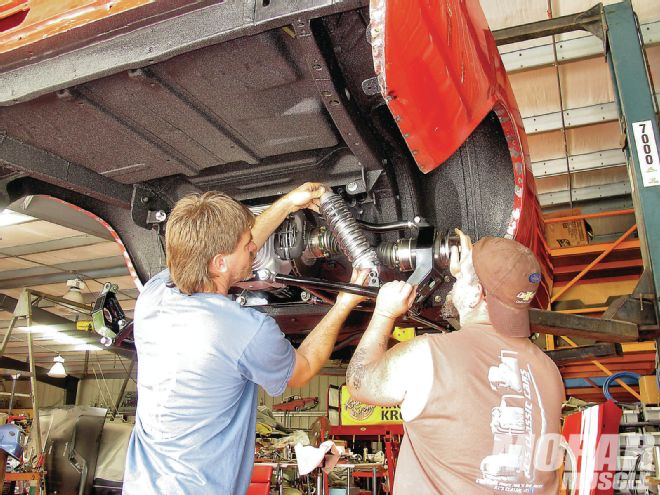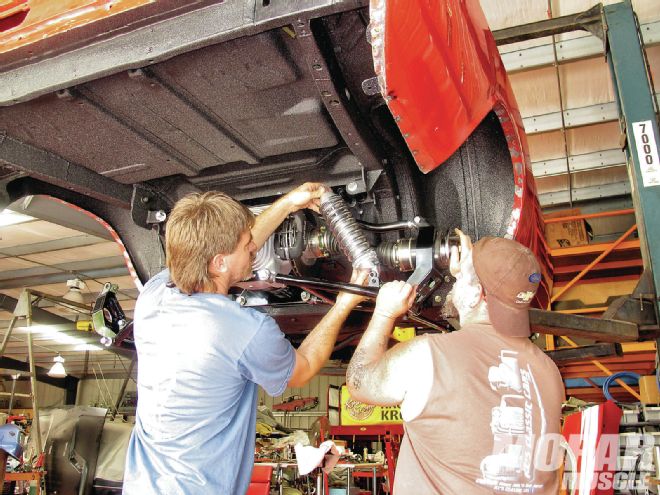
When your classic Mopar came from the factory, the live axle, or solid rear axle rear, was the OE choice. A live axle consists of a centrally-located differential within a single housing. This housing also contains the axles that connect the differential to the wheels. The differential is connected to the transmission by a driveshaft that has a universal at each end. The reason for the universals is because when the rear suspension moves, this allows the rear end to also move, and the universals must be in place to compensate for the angle changes that the driveshaft sees during these movements. The main advantage of using a solid axle is that it is simple and relatively inexpensive to manufacture. Its drawbacks, however, are that it doesn't allow each wheel to move independently in response to bumps, and the weight of the assembly is part of the vehicle, which can limit ride quality.
Because a solid axle doesn't exhibit camber change as the suspension travels, they are ideal for carrying heavy or varying loads. Although this negatively impacts cornering as compared to other suspension designs (because the wheels have zero camber gain during body roll).
Independent rear suspensions typically offer a better ride quality and handling characteristics because of their lower unsprung weight, and the ability of each wheel to remain in contact with the road when the opposite side experiences an uneven surface (read: pot hole). Independent rear suspensions do, however, require a significant amount of additional engineering and expense in development.
The reason for the lower unsprung weight of an IRS, as opposed to a solid axle, is that the axle does not mount to the springs or suspension system. Instead, it is either bolted directly to the vehicle's chassis, or--more commonly--to a subframe.
The relative movement between the wheels and the differential is achieved through the use of swinging driveshafts connected by constant-velocity (CV) joints.
Since the movement of each rear wheel is not affected by the other, the vehicle is able to maintain traction where a solid-axle equipped vehicle might lose contact with the driving surface. This also works to maximize tire performance, as independent suspensions allow the tread to contact the road over a great surface area, allowing the tire to wear more evenly and extend life.
Independent rear suspensions do offer both pros and cons when it comes to performance usage. While it's true that an independent rear suspension gives a car better cornering ability, since there is less unsprung weight to pull against the driver's steering, IRS cars will usually see a lower performance outcome when racing in a straight line.
Independent rear suspensions became popular among custom hot rod designers just as they were appearing on factory sports car models. For these do-it-yourself car designers, an independent rear suspension was also a chance to give a vehicle a unique look. Even today, hot rods often include elaborate, chrome-plated rear suspensions that are easily visible to drivers behind the car, making a visual statement and showing the designer's attention to detail.
But is it worth your time and expense to put an IRS in your Mopar? Only you can answer that, but if the answer is yes, Heidts can help you with that project. Although $7,995 is a big chunk of change for the upgrade, as we explained earlier, a modern independent rear suspension does have its benefits. So to get the skinny from the guys who actually build the kits, we asked Mike Hawley, Heidts sales manager, to explain why buying this kit is worth the money: "This Universal HHP IRS is an excellent solution for classic Mopar builders. Obviously, the current LX-platform cars utilize an IRS, so it's an ideal means for builders and customers to modernize their older cars with comparable ride and handling characteristics. Since this new universal IRS is rated for high horsepower applications, they [will also hold up to just about anything you can throw at it]. Quite simply, this is the most cost-effective means to get a modern IRS, with its outstanding ride and handling, under an earlier Mopar chassis. We can't wait to see what kind of Mopar muscle will be built with this IRS under it!"
Actually, when we started writing this, they were in the early stages of having a universal IRS kit available for all muscle cars, and we got the chance to travel to KC's Classic Cars in Bradenton, Florida, as they completed an install into a '70 Challenger. Hopefully the guys at KC's and Heidts can get together and make a true Mopar IRS kit. Please remember that this is not a bolt-in kit, and is not for the novice installer. You will be required to weld and fabricate mounts and brackets to support the trailing arms and such, so be ready. The new universal IRS features a fully-welded and boxed, cut-to-fit upper crossmember, heavy-duty upper and lower control arms, fully welded uprights, heavy-duty CV-joints and axleshafts, as well as Heidts' own cast centersection that can be loaded with a wide range of gear ratios and differentials. The Heidts IRS also makes use of standard 101?2-inch inboard mounted disc brakes with four-piston Wilwood calipers. Based upon the intended vehicle application, the kit is available in both 56- and 58-inch framerail width versions. Finally, we asked Mike why he would tell Mopar guys that changing to a Heidts IRS is worth doing. He replied: "For the classic Mopar muscle cars, there is simply nothing else out there like the Heidts IRS. The Heidts High Horsepower Universal IRS allows owners to update their classic Mopar muscle with a proven, industry-leading IRS solution without having to fabricate their own, saving themselves a lot of time, money, and hassle."
Price Tag
PartPNCost Universal Independent Rear endIRU-101 - smooth brake rotors; IRU-101-D - drilled and slotted brake rotors$7,995
Terms you need to Know
Unsprung weight: the weight of the suspension, wheels, and other components directly connected to the springs.
Sprung weight: the mass of the body and other components supported by the suspension.
Camber angle: the angle between the vertical axis of the wheel and the vertical axis of the vehicle when viewed from the front or rear. If the top of the wheel is tipped out more than the bottom, that's called positive camber. Likewise, if the bottom of the wheel is farther out than the top, it's said to have negative camber.
 <STRONG>15</STRONG> Although this kit will take some fabrication skills to install, having an independent rear in your Mopar is a really cool feature. Now you just need to get yours.
<STRONG>15</STRONG> Although this kit will take some fabrication skills to install, having an independent rear in your Mopar is a really cool feature. Now you just need to get yours.